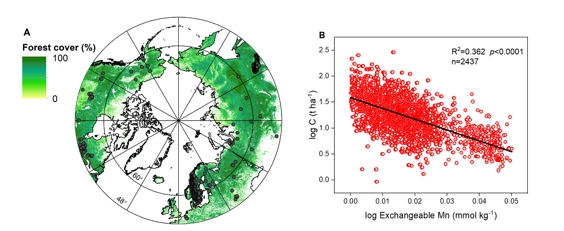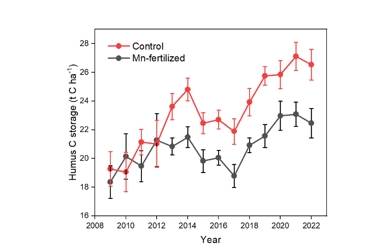Scientists Discovered Methods to Regulate Carbon Storage in the Humus Layer of Northern Forest
According to estimation, 30% of the world's terrestrial carbon (C) stocks are found in the boreal forest, with 60% of this C being underground. Organic soil horizons contain approximately one-third of the soil C. Therefore, the stability of boreal soils is critical to understanding global C cycle to climate change and soil management. Yet, regulating factors of humus C sequestration in the boreal forests globally is remains uncertain.
Affiliated with Institute of Applied Ecology, Chinese Academy of Sciences, Dr SUN Tao and his team have devoted to the research of litterfall and soil carbon. They manipulated two independent but complementary experiments and then demonstrated that exchangeable manganese (Mn) is a critical factor regulating C accumulation in boreal forests across both regional scales and the entire boreal latitudinal range. Based on a meta-analysis encompassing the whole boreal zone, not only did they ascertain that exchangeable Mn was an important factor controlling long-term humus C sequestration in boreal forest soils, they also provided the first global generalized Mn effect on organic soil C stocks for boreal forests (Fig. 1). Notably, in a 14-years fertilization experiment, Mn addition reduced soil C stocks, but this effect of Mn addition was not apparent until after 4 years (Fig. 2).
Their research revealed that exchangeable Mn is essential for the preservation of the humus in boreal forests, to the extent where changes in global C cycles may be substantially affected in the decades. Thus, their work suggests that a more accurate representation of Mn-mediated mechanisms affecting C storage in biogeochemical models will increase confidence in the model's structure, parameter estimations, and forecasts for the processes of soil organic matter production and litter breakdown.
Entitled Exchangeable manganese regulates carbon storage in the humus layer of the boreal forest, this article is published in Proceedings of the National Academy of Sciences of the United States of America. This research was supported by the National Natural Science Foundation of China, National Key R&D Program of China, the International Partnership Program of CAS, and Excellent Member of Youth Innovation Promotion Association of CAS to Tao Sun. Researchers from University of Minnesota, Duke University and University of Helsinki participated in the study.

Fig. 1 Relationship between exchangeable Mn concentrations and soil C stocks in humus layers of boreal forests. (A) Area of boreal forest and location of study sites in the database (n = 2538). (B) Log-log regression between C stocks and exchangeable Mn in the humus layer (n = 2437)(Image by SUNTao).

Fig. 2 Effect of annual experimental Mn fertilization (MnSO4) on humus C storage of boreal forest over 14 years. Points show mean soil C stocks in organic horizons (humus) in control and Mn-fertilized plots in a Larix gmelinii stand in boreal China (Huzhong Forest Bureau of Daxing'an Mountains). Bars are means ± SEM(Image by SUNTao).
YUE Qian
Institute of Applied Ecology, Chinese Academy of Sciences
Tel: 86-24-83970317
E-mail: yueqian@iae.ac.cn
Web: http://english.iae.cas.cn



